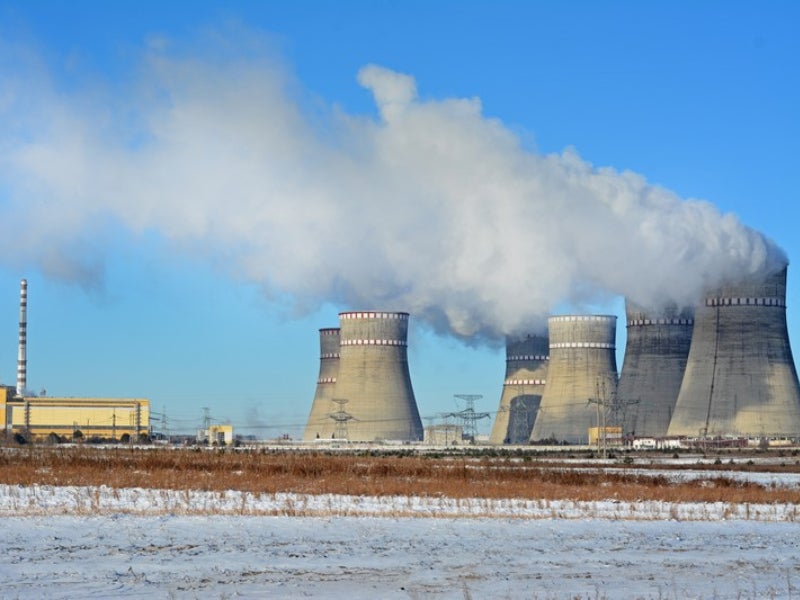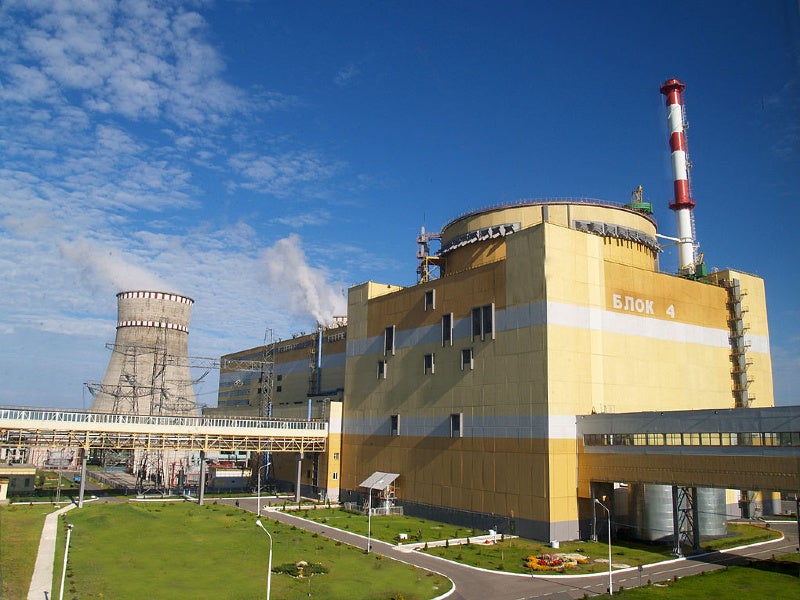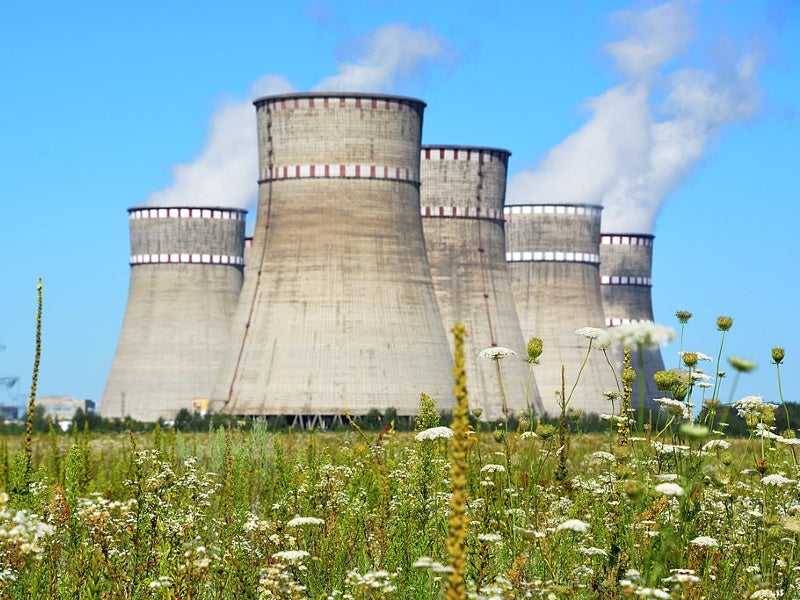Understand the impact of the Ukraine conflict from a cross-sector perspective with the Global Data Executive Briefing: Ukraine Conflict
The Rivne nuclear power plant (NPP), also called the Rovno NPP, is located near Varash in Rivne Oblast and is the biggest power station in western Ukraine. It is also the oldest among the four active NPPs operated by Ukraine’s state-owned nuclear energy generating company, Energoatom.
The 2.8GW power station houses four Russian-designed pressurised water reactors (PWRs), of which the first three units were commissioned between 1980 and 1986 when Ukraine was part of the former Soviet Union. The last unit was commissioned in 2004.
Rivne NPP supplied more than 15,796 gigawatt-hours (GWh) of electricity to the Ukrainian national grid in 2020.
In December 2010, the State Nuclear Regulatory Inspectorate of Ukraine (SNRIU) approved the lifetime extension of the first two 440MW power units of the NPP until December 2030 and December 2031, respectively.
It also issued a licence in July 2018 to extend the operating life of the 1,000MW Rivne-3 unit until December 2037. The initial design life of the 1,000MW Rivne-4 unit expires in December 2035.
Location and site details
The Rivne NPP is located on the bank of the Styr River, 3km east of Varash (formerly called Kuznetsovsk), at the border of the Rivne and Volyn regions in western Ukraine.
The district centre of Vladimirets lies 20km to the north-east and the Kyiv-Kovel highway is located 20km south of the plant site.
Construction of the Rivne NPP
The design of the Rivne NPP, initially called the West-Ukraine NPP project, began in 1971, while construction works started in 1973.
The first two power units, with VVER-440 reactors, were brought online in 1980 and 1981, respectively, while Unit 3, with a VVER-1000 reactor, was commissioned in 1986. Rivne was the first Ukrainian NPP to use VVER-440 reactors.
Construction of Unit 4, with another VVER-1000 reactor, was suspended in 1990 due to the moratorium on the construction and commissioning of new nuclear reactors in Ukraine following the Chernobyl NPP disaster in 1986.
Work on the fourth unit resumed after the moratorium was lifted in 1993. Rivne-4 was connected to the grid in October 2004, and commercial operations started in April 2006.
Rivne nuclear power plant make-up
Units 1 and 2 of the Rivne nuclear power plant comprise two water-cooled water-moderated VVER-440 (V-213) reactors in separate buildings, along with a K-220-44 steam turbine and TVV-220-2AUZ generator in a common turbine building.
Each VVER-440 reactor of the NPP features six coolant loops, with each loop consisting of reactor coolant piping, GTsN-317 main coolant pump and PGV-213 steam generator.
Units 3 and 4 are each equipped with a VVER-1000 (V-320) reactor, with four coolant loops and horizontal steam generators, as well as a K-1000-60/3000 steam turbine paired with a TVV-1000-2UZ generator. Each unit has its own reactor and turbine buildings.
The design of the VVER-1000 reactors used at Rivne is similar to that of the six units operating at Zaporizhzhya, Europe’s biggest NPP, which is located in Energodar, Ukraine.
The reactor core of each of the four VVER power units at Rivne is placed within a steel pressure vessel with 20cm-thick walls. Each pressure vessel is enclosed within a steel reinforced concrete containment building.
Cooling infrastructure of Rivne nuclear power plant
The Rivne NPP uses water from the nearby Styr River for cooling. It uses six natural draft cooling towers of 100,000m³/h capacity each.
A total of 14 diesel generators (DGs) are used at the power station to provide emergency cooling in the absence of an external power supply. Each unit uses three DGs, while two additional DGs for common use are located at Unit 4.
Power transmission
The electricity generated by the Rivne nuclear power plant is fed into the national grid through two 750kV, four 330kV and five 110kV transmission lines.
Ukraine’s national grid operator, Ukrenergo, completed the 353km-long Rivne-Kyiv 750kV transmission line to deliver surplus power from the country’s western region to the power-deficit central region in December 2015.
The European Bank for Reconstruction and Development (EBRD) and European Investment Bank (EIB) provided loans for the UAH5.82bn ($215m) Rivne-Kyiv high-voltage (HV) transmission project, which also involved the modernisation of the Kyivska substation.
Fuel supply
TVEL Fuel Company, part of Russia’s State Atomic Energy Corporation (Rosatom), was the fuel supplier for all four units of the Rivne NPP.
However, Energoatom decided to start using fuel assemblies supplied by Westinghouse, a company based in the US, for all the Rivne power units. This decision was in line with Ukraine’s strategy to diversify nuclear fuel supply and reduce its dependence on the Russian supplier.
The first batch of 42 Westinghouse fuel assemblies for Unit 3 of the Rivne nuclear power plant was delivered to the plant site in July 2021. Loading into the reactor core is expected in 2022. Rivne-3 is expected to switch entirely to Westinghouse fuel by 2026.
Similarly, the first batch of 12 Westinghouse fuel assemblies is planned to be loaded into the Rivne-2 VVER-440 reactor core in 2024.
Proposed small modular reactors (SMRs) at Rivne
Energoatom and Holtec International signed a memorandum of understanding (MoU) in March 2018 to build six SMR-160 modular reactors at the Rivne nuclear power station to replace the two ageing VVER-440 power units at the site from 2030.
Subsequently in March 2019, Energoatom, Holtec, and Ukraine’s State Scientific and Technology Center (SSTC) forged a trilateral consortium partnership to advance the deployment of SMR-160 nuclear reactors in Ukraine.
Contractors involved
Westinghouse Electric was contracted to supply nuclear fuel for the two VVER-440 reactors of the Rivne NPP in September 2020.
AtomRemontService, an Energoatom subsidiary that oversees maintenance and repairs of all Ukrainian NPPs, contracted General Electric (GE) Steam Power to provide generator maintenance services at the Rivne nuclear power station for a period of three years in July 2020.
Ukraine-based technology company Radiy supplied the field programmable gate arrays (FPGA)-based RadICS digital safety instrumentation and control (I&C) system for the Rivne NPP in 2017.
Kyiv Institute of Energy Projects (KIEP) has been providing engineering support services for the operation, as well as safety assessment and improvement of the nuclear power facility, since 1987. It also developed a radioactive waste (RAW) processing complex at the Rivne nuclear power plant in 2018.
Kalpataru Power Transmission, a company based in India, completed the construction of the 750kV Rivne-Kyiv transmission line in December 2015.
The power equipment and engineering company Dalekovod, based in Croatia, secured a contract worth more than €43m ($47m) to modernise and upgrade the Kyivska transformer station as part of the Rivne-Kyiv HV transmission line project in August 2015.






